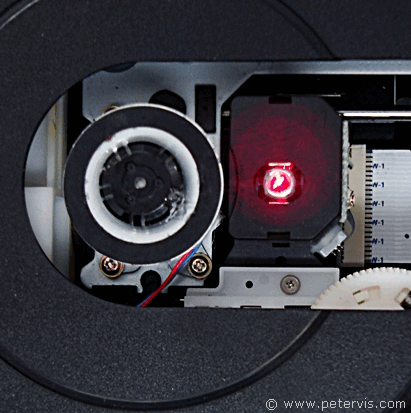NO DISC error on a CD / DVD player

If you are getting a NO DISC error on a CD / DVD player, then chances are the laser has failed.
A typical symptom is you insert a disc in the player and after a while; the CD tray opens again with the message referring to no disc being in the system. This can be infuriating because you can see that there is a disc, however, the CD / DVD player cannot.
Every time the tray closes, the laser beam fires two long bursts of laser light, and the focusing platform moves up and down attempting to focus the beam. This is the time when it is looking for a disc. If the laser has failed, then it will not be able to detect a CD and therefore the error message appears.
I normally do two things when this happens. I normally clean the lens just in case there is dust on it obstructing the laser path. If cleaning the lens does not solve the problem then I make sure the laser is working.
Obviously one should never look directly into the laser unit, you would have to be plain stupid if you did that. The laser light is bright enough that one can see the diffused red light from a distance obliquely. A piece of paper the size of a standard CD within the tray can also help, because when the tray closes, one can see the diffused red light on the paper. It is usually bright enough and visible from the other side of the paper. If there is no red light, then the laser has failed.
Back in the 1990s, I used to fix many of these and it was always either the spindle motor or the laser that failed. These two components are in constant use and wear out the most.
Laser diodes do not last forever, especially on the early players manufactured in the 1980s. It would be very surprising to find a player still working from that era.
Most of those units used cheap motors where the brushes wore out within a few years. Moreover, if that did not fail, then the laser surely would. The laser diode manufacturing process was not as refined either, and those diodes had a short finite life to them. Most of those early CD players would be hard to find as they often ended up in landfill.
I have come across many high-end players of recent time that use the same cheap mass produced drive mechanisms. Moreover, most of those failed within a few years as well. This is a shame, as one would expect high-end players to have better components for the mechanism; however, it is usually the same cheap mechanism found in unbranded supermarket models.
A laser diode, being a semiconductor, fails in an interesting way. When it is reaching the end of its useful life, and about to fail, it becomes, unstable. Its operation becomes sporadic, which can confuse the user. It might work one minute, but not work the next. Alternatively, it might work for some CDs and not for others.
From the user's point of view the player initially starts becoming temperamental, and then stops working completely and unable to read any disc.
If you have an old player that is getting temperamental, then now is the time to buy a new one. I would highly recommend a Blu-ray CD player. The latest players have more functions, better picture quality, and are at half the price!
